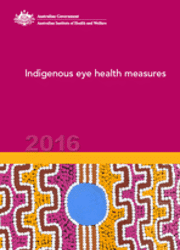Summary
- This first national report on the Indigenous eye health measures compiles data from a range of sources and presents findings at the national, state and regional levels.
- In 2016 the prevalence of bilateral vision impairment for Indigenous Australians aged 40 and over was 10.5% and the prevalence of bilateral blindness was 0.3% (both affecting an estimated 18,300 Indigenous Australians aged 40 and over).
- The 3 leading causes of vision impairment for older Indigenous adults were refractive error (63%), cataract (20%) and diabetic retinopathy (5.5%).
- Repeated untreated trachoma infections are a cause of vision loss in some remote Indigenous communities, but the prevalence of active trachoma in children aged 5–9 in at-risk communities fell from 14% in 2009 to 4.6% in 2015.
- The age-standardised proportion of Indigenous Australians who had had an eye examination by an eye-care professional in the preceding 12 months increased from 13% in 2005–06 to 15% in 2014–15.
- There were 6,404 hospitalisations (4.5 per 1,000) of Indigenous Australians for eye procedures in the two year period 2013–15.
- Between 2005–07 and 2013–15 the age-standardised Indigenous hospitalisation rate for cataract surgery increased by over 40% from 4,918 to 7,052 per 1,000,000.
- In 2014–15, the median waiting time for elective cataract surgery was 142 days for Indigenous Australians, with 3.4% of Indigenous Australians who waited for more than 1 year for cataract surgery.
- Hospitalisation rates for cataract surgery were higher for Indigenous Australians in Remote and Very remote areas combined, while waiting times were longest in Inner regional areas.
- The number of occasions of service for Indigenous patients under the Visiting Optometrists Scheme (VOS) almost tripled between 2009–10 and 2014–15 rising from 6,975 to 18,890.
Comparison with non-Indigenous Australians
- Indigenous Australians suffered from vision impairment or blindness at 3 times the rate of non-Indigenous Australians, based on age-standardised rates.
- In 2014–15, a lower proportion of Indigenous Australians (15%) had had an eye examination by an optometrist or ophthalmologist in the preceding 12 months compared with non-Indigenous Australians (20%), based on age-standardised rates.
- Indigenous Australians had a lower age-standardised rate of hospitalisations for eye diseases compared with non-Indigenous Australians (10 and 13 per 1,000, respectively), but 3 times the rate for injuries to the eye (1.3 and 0.4 per 1,000, respectively).
- Indigenous Australians also had a lower age-standardised rate of hospitalisations for cataract surgery than non-Indigenous Australians (7,044 and 8,415 per 1,000,000, respectively).
- In 2014–15, the median waiting time in days for those who had elective cataract surgery was longer for Indigenous Australians (142) than for non-Indigenous Australians (84).



